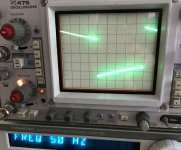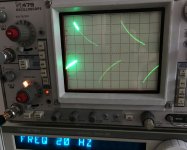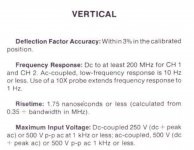I have been looking for a signal/function generator to do some square wave testing. I got a good deal on a Wavetek 288 and figured I'd be in business. However, when I hooked it up, even the 100hz square wave was showing a decent amount of attenuation. I've included some photos.
Is this normal? I've seen tests on amplifiers with 20hz square waves looking fine. What generator will give me a good enough signal to really see what is going on in the lower frequencies?
* To clarify...the function generator is hooked up directly to the o-scope, not being run through another device.
Is this normal? I've seen tests on amplifiers with 20hz square waves looking fine. What generator will give me a good enough signal to really see what is going on in the lower frequencies?
* To clarify...the function generator is hooked up directly to the o-scope, not being run through another device.
Attachments
Last edited:
I got a good deal on a Wavetek 288 and figured I'd be in business. However,
when I hooked it up, even the 100hz square wave was showing a decent amount
of attenuation.
Your scope is set to AC input coupling, try DC coupling.
Bingo! Thanks!! Should I just leave it on DC unless I have a problem w/ offset? Or is there any other reason I'd want to use it AC coupled.
So would AC coupling be good for things like measuring power supply ripple or other AC components on top of a DC voltage? Otherwise...keep it on DC for other testing?
So would AC coupling be good for things like measuring power supply ripple or
other AC components on top of a DC voltage? Otherwise...keep it on DC for other testing?
Sometimes you have to use AC coupling, like for a signal with a large DC component,
or just for general work. Anything to do with LF, use DC coupling.
AC coupling puts a capacitor in series with the signal.
So at low frequencies what you are seeing is the capacitor discharging a bit and so a slope instead of a straight line.
So at low frequencies what you are seeing is the capacitor discharging a bit and so a slope instead of a straight line.
Thanks! That was actually the first thing I did when I brought the scope home. Although one seems to be broken now. It appears locked into the proper compensation, but when I turn the screw nothing happens anymore. It was free (came w/ the scope), so no biggie.
BTW, these measurements were just with a bnc-rca connector and a cable between function generator and scope.
BTW, these measurements were just with a bnc-rca connector and a cable between function generator and scope.
The capacitance of that cable may introduce the same effects as a uncalibrated probe, did you try the cable you used on the calibration signal out of the scope? If the generator looks square on the scope then you dont need calibration, just curious.
I tried calibrated probes too after I first saw the waves (and figured it might be the rca cable) and they showed the same attenuation. Since switching to DC, it works fine now (including with the rca cable).
Interesting. I did try 10x probes while AC coupled and the square wave attenuation was identical to using the cable. Surprised that 1hz didn't have a better response than 10hz. Of course the level isn't mentioned in that frequency response. Might be 3db down in either case.
Well, as you know the square wave is square in DC mode, you could probably figure it out [emoji848]Interesting. I did try 10x probes while AC coupled and the square wave attenuation was identical to using the cable. Surprised that 1hz didn't have a better response than 10hz. Of course the level isn't mentioned in that frequency response. Might be 3db down in either case.
- Status
- Not open for further replies.
- Home
- Design & Build
- Equipment & Tools
- Square wave question (Wavetek 288)




